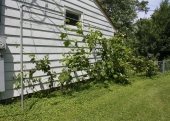




Tiny garden in the green Basque Country




Idle dreamer

 1
1




Dave de Basque wrote:Just thought I would put out a crazy idea here for more experienced people to slap down. Or not.
3ha/7 acres southwest-facing sunny grass. 12-20% slope. Soil=fairly nutrient-rich clay, short on phosphorous, fine otherwise.
Climate = fairly humid year-round. Powdery mildew is a problem with some plants, assume this would be true with the grapes.
There are conventional wine grape producers in the area that do fairly well for themselves. There is a particular style of coastal green wine called "txakoli" that is gaining traction in the international marketplace. And of course pinot noir and a couple of other things I could try in a mild coastal climate.
So here are my questions:
--Where can I find out about the ins and outs of growing wine grapes organically and its challenges? Book recommendations? Websites? Bonus if it takes into account a humid climate similar to the coastal Pacific Northwest in the USA.
--How long after I plant new vines would it be until I have a crop? Until the vineyard is in full production?
--What are the realistic labor requirements?
--Would the predominance of cool, humid weather (nice for mildew-like spores) be too much for organic growing methods?
--Is this, as it seems, a decent money-maker? At least potentially? And if so, under what circumstances?
Thanks for all your permie wisdom
List of Bryant RedHawk's Epic Soil Series Threads We love visitors, that's why we live in a secluded cabin deep in the woods. "Buzzard's Roost (Asnikiye Heca) Farm." Promoting permaculture to save our planet.
 1
1





Living in Anjou , France,
For the many not for the few
http://www.permies.com/t/80/31583/projects/Permie-Pennies-France#330873




Visit Redhawk's soil series: https://permies.com/wiki/redhawk-soil
How permies.com works: https://permies.com/wiki/34193/permies-works-links-threads
 1
1




Dave de Basque wrote:--Where can I find out about the ins and outs of growing wine grapes organically and its challenges? Book recommendations? Websites? Bonus if it takes into account a humid climate similar to the coastal Pacific Northwest in the USA.
Grapes typically start producing during their second or third growing season.--How long after I plant new vines would it be until I have a crop?
I'd ballpark five years but I'm only in the beginning phase of my own experiments with grapes and answering on hearsay.Until the vineyard is in full production?
Depends on which pruning methods you go for. Based on everything I've read optimal production does require some form of pruning.--What are the realistic labor requirements?
No but it will dictate which cultivars will work for you.--Would the predominance of cool, humid weather (nice for mildew-like spores) be too much for organic growing methods?
It's most profitable if you open your own winery, rather than selling to others.--Is this, as it seems, a decent money-maker? At least potentially? And if so, under what circumstances?










Tiny garden in the green Basque Country
















List of Bryant RedHawk's Epic Soil Series Threads We love visitors, that's why we live in a secluded cabin deep in the woods. "Buzzard's Roost (Asnikiye Heca) Farm." Promoting permaculture to save our planet.




















List of Bryant RedHawk's Epic Soil Series Threads We love visitors, that's why we live in a secluded cabin deep in the woods. "Buzzard's Roost (Asnikiye Heca) Farm." Promoting permaculture to save our planet.




This is all just my opinion based on a flawed memory













 1
1




Ben Zukisian wrote:In the long run, my understanding is that if you don't dry farm grapes they will never reach their full potential in terms of quality and drought resistance. This is why irrigation of vineyards is not allowed in France. A little help in the height of summer in the first year is okay, but really if we lose vines we did not mulch enough or the vine was weak.
List of Bryant RedHawk's Epic Soil Series Threads We love visitors, that's why we live in a secluded cabin deep in the woods. "Buzzard's Roost (Asnikiye Heca) Farm." Promoting permaculture to save our planet.




-- Wisdsom pursues me but I run faster.




-




This is all just my opinion based on a flawed memory


|
Right! We're on it! Let's get to work tiny ad!
GAMCOD 2025: 200 square feet; Zero degrees F or colder; calories cheap and easy
https://permies.com/wiki/270034/GAMCOD-square-feet-degrees-colder
|


